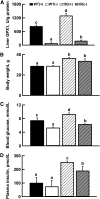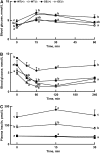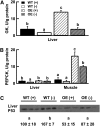Dietary selenium deficiency partially rescues type 2 diabetes-like phenotypes of glutathione peroxidase-1-overexpressing male mice
- PMID: 23014491
- PMCID: PMC3497934
- DOI: 10.3945/jn.112.164764
Dietary selenium deficiency partially rescues type 2 diabetes-like phenotypes of glutathione peroxidase-1-overexpressing male mice
Abstract
This study was conducted to determine whether dietary Se deficiency precluded overproduction of glutathione peroxidase-1 (GPX1) activity in mice overexpressing (OE) this gene and thus rescued their type 2 diabetes-like phenotypes. A total of 20 male OE and wild-type (WT) mice were fed an Se-deficient (<0.02 mg/kg) diet or an Se-supplemented (0.3 mg/kg as sodium selenite) diet from 1 to 5 mo of age. Dietary Se deficiency eliminated or attenuated (P < 0.05) genotype differences in concentrations of blood glucose, plasma insulin, and/or hepatic lipids, insulin sensitivity, and glucose-stimulated insulin secretion at the end of the study. Dietary Se deficiency decreased (P < 0.05) OE islet mRNA levels of 2 key transcriptional activators (Beta2 and Foxa2) and removed genotype differences in islet mRNA levels of 7 genes (Beta2, Cfos, Foxa2, Pregluc, Ins1, p53, and Sur1) related to insulin synthesis and secretion. Compared with those of the Se-adequate OE mice, the Se-deficient OE mice had lower (P < 0.05) hepatic mRNA levels of 2 key rate-limiting enzymes for lipogenesis (Acc1) and glycolysis (Gk1), along with lower (P < 0.05) activities of hepatic glucokinase and muscle phosphoenolpyruvate carboxykinase. Dietary Se deficiency also decreased (P < 0.05) blood glucose and hepatic lipid concentrations in the WT mice. In conclusion, dietary Se deficiency precluded the overproduction of GPX1 in full-fed OE mice and partially rescued their metabolic syndromes. This alleviation resulted from modulating the expression and/or function of proinsulin genes, lipogenesis rate-limiting enzyme genes, and key glycolysis and gluconeogenesis enzymes in islets, liver, and muscle.
Conflict of interest statement
Author disclosures: X. Yan, M. P. Pepper, M. Z. Vatamaniuk, C. A. Roneker, L. Li, and X. G. Lei, no conflicts of interest.
Figures







References
-
- Mueller AS, Pallauf J. Compendium of the antidiabetic effects of supranutritional selenate doses. In vivo and in vitro investigations with type II diabetic db/db mice. J Nutr Biochem. 2006;17:548–60 - PubMed
-
- Faure P. Protective effects of antioxidant micronutrients (vitamin E, zinc and selenium) in type 2 diabetes mellitus. Clin Chem Lab Med. 2003;41:995–8 - PubMed
-
- Ezaki O. The insulin-like effects of selenate in rat adipocytes. J Biol Chem. 1990;265:1124–8 - PubMed
-
- Navarro-Alarcón M, Lopez-G de la SH, Perez-Valero V, Lopez-Martinez C. Serum and urine selenium concentrations as indicators of body status in patients with diabetes mellitus. Sci Total Environ. 1999;228:79–85 - PubMed
Publication types
MeSH terms
Substances
Grants and funding
LinkOut - more resources
Full Text Sources
Other Literature Sources
Medical
Molecular Biology Databases
Research Materials
Miscellaneous

